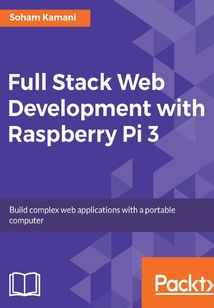目錄(154章)
倒序
- cover
- Title Page
- Copyright
- Full Stack Web Development with Raspberry Pi 3
- Credits
- About the Author
- About the Reviewers
- www.PacktPub.com
- Why subscribe?
- Customer Feedback
- Preface
- What this book covers
- What you need for this book
- Who this book is for
- Conventions
- Reader feedback
- Customer support
- Downloading the example code
- Downloading the color images of this book
- Errata
- Piracy
- Questions
- Getting Started on the Raspberry Pi
- The Internet of Things
- A brief look at our application
- The sensor interface - perception
- The database - persistence
- The user interface - presentation
- The application server - middleware
- Setting up our Raspberry Pi
- Remote access
- Summary
- Getting Up-and-Running with Web Development on the Raspberry Pi
- The network
- The web development stack
- The UI - the user's first encounter
- The server - the brains of the application
- Client-server communication
- Interfacing with external hardware
- The database - adding persistence to our data
- Integrating the database into our application
- The overall architecture
- Summary
- Running a Node Server on the Pi
- Introducing nodes - the server side JavaScript runtime
- Installing node on the Pi
- Running our first node program
- Setting up a version control system
- Back to our program
- Installing external libraries
- Developing the application server
- Adding routes to the server
- Starting up the server
- Keeping the server running in the background
- Summary
- Extracting Information from the GPIO Pins
- The GPIO pins on the Pi
- The pin as a standalone component
- The Write mode
- The Read mode
- Fine-tuning our control - using the GPIO command-line tools
- The DHT11 sensor
- Reading from the sensor
- Summary
- Retrieving Sensor Readings from the Server
- Understanding how our node process takes readings
- Modifying our server code to show sensor readings
- Optimizing our server
- Abstracting our sensor library code
- Caching our results
- Summary
- Creating a Web Page to Display Sensor Data
- Extending our application
- Serving static files from the Express server
- Building the UI's functionality
- Adding client-side JavaScript
- Fetching sensor readings using XHR
- Visually enhancing the UI
- Changing the structure of our UI
- Adding style to the newly modified structure
- Summary
- Enhancing Our UI - Using Interactive Charts
- Considerations when implementing complex features
- Introducing Chart.js
- Installing Chart.js
- Creating our first chart
- Making the server response data-friendly
- Modifying the sensor dashboards to consume JSON data
- Integrating sensor data into our charts
- A code overview
- index.js
- public/index.html
- public/script.js
- Summary
- SQLite - The Fast and Portable Database
- Picking the correct tool for the job
- Installation
- Creating the temperature and humidity tables
- Running CRUD operations
- Create
- Read
- Update
- Delete
- Aggregations
- Advanced aggregations using subqueries
- Summary
- Integrating SQLite into Our Application
- Getting started: Interfacing SQLite with node
- Running queries with node
- Making our database module
- Adding a new temperature to the database
- Fetching the last "n" readings from a table
- Fetching readings between a certain time period
- Fetching the average of readings between time periods
- Putting the functions together in a module
- Integrating the database module into our server application
- Upgrading the sensor interface module
- Adding an API to get the latest ten readings
- Consuming the API on the client side
- Adding new features - the ability to view readings from a custom time period
- Adding the required APIs
- Summary
- Making our Application Real Time with Web Sockets
- Web sockets
- Implementing web sockets in our application
- The socket.io library
- Client-side installation
- Server-side installation
- Creating our socket implementation in our application server
- Client-side implementation
- Summary
- Deploying our application to Firebase
- The Firebase platform
- Migrating to Firebase
- The User interface
- Database
- Server application and sensor interface
- Creating your first Firebase application
- Installing the Firebase CLI
- Logging in to Firebase on the command line
- Initializing a new Firebase application
- Testing and deploying the application to the cloud
- Migrating the frontend assets
- Adding Firebase tools
- Adding the Realtime Database
- Enabling access to the Firebase Database
- Adding listeners to the client-side script
- Summary
- Using Firebase APIs to Update Our Application
- Application server versus application process
- Securing our application
- The application process architecture
- Implementing the application process
- Summary 更新時間:2021-07-15 17:10:53
推薦閱讀
- Mastering Concurrency Programming with Java 8
- Dynamics 365 for Finance and Operations Development Cookbook(Fourth Edition)
- 案例式C語言程序設計
- Instant Apache Stanbol
- Mastering Concurrency in Go
- Internet of Things with the Arduino Yún
- 從學徒到高手:汽車電路識圖、故障檢測與維修技能全圖解
- Unity 5.x By Example
- Python算法從菜鳥到達人
- Python Data Structures and Algorithms
- JavaScript動態網頁編程
- 大學計算機基礎實驗指導
- PowerDesigner 16 從入門到精通
- Arduino機器人系統設計及開發
- Modular Programming with JavaScript
- ASP.NET jQuery Cookbook(Second Edition)
- 情境微課開發(第2版)
- VMware vRealize Orchestrator Essentials
- μC/OS-III源碼分析筆記
- Swift Essentials
- ATmega16單片機C語言程序設計經典實例
- Spring MVC:Beginner's Guide(Second Edition)
- Learning JavaScript Data Structures and Algorithms
- U一點·料:阿里巴巴1688UED體驗設計踐行之路
- 自動化運維軟件設計實戰
- Instant Sikuli Test Automation
- Django RESTful Web Services
- Lumion 3D Best Practices
- Voice User Interface Projects
- 從零開始:Python快速入門教程


